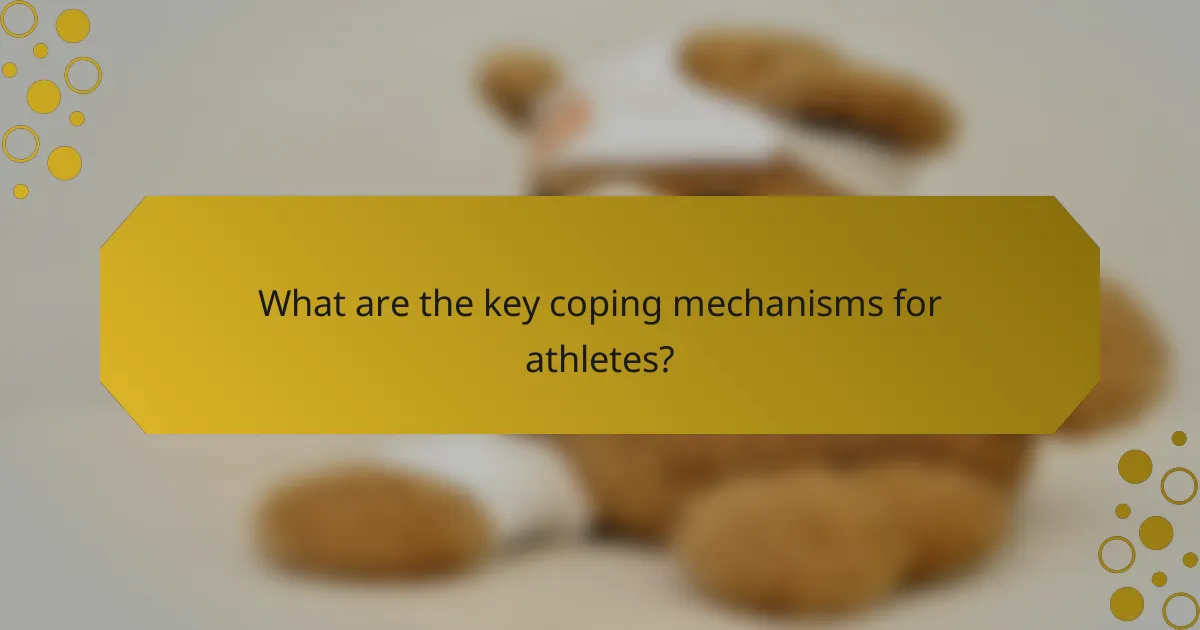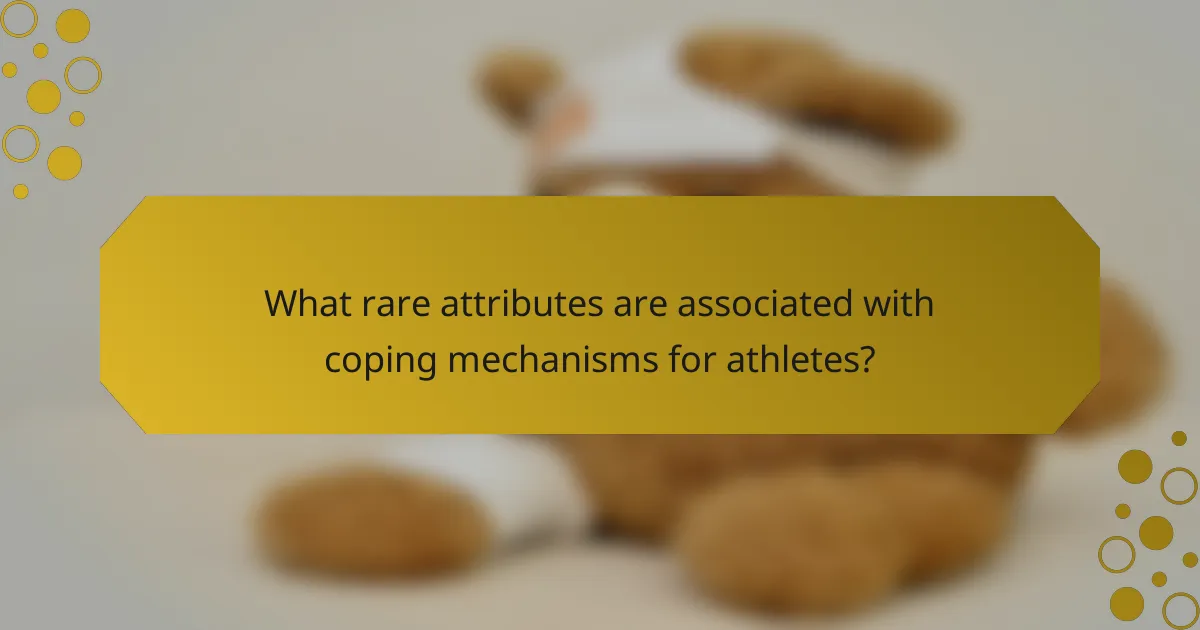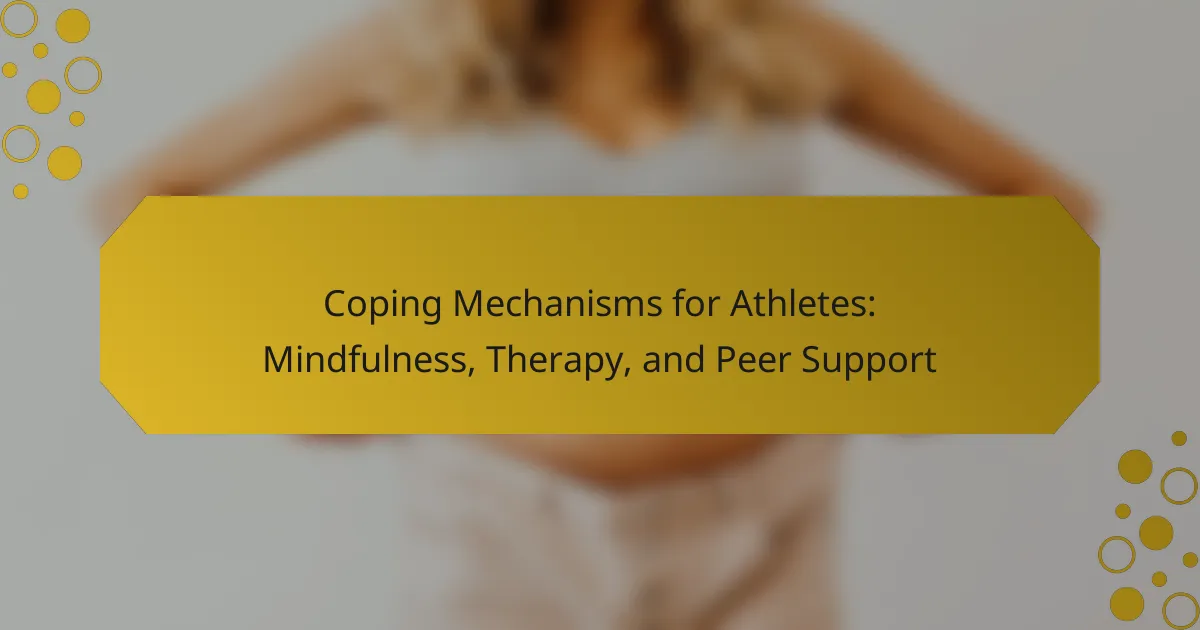Athletes often face significant stress that can impact their performance and mental health. Mindfulness techniques enhance focus and reduce anxiety. Therapy provides personalised emotional support and coping strategies. Peer support fosters community and shared experiences, promoting resilience among athletes. Together, these coping mechanisms contribute to improved well-being and performance.

What are the key coping mechanisms for athletes?
Athletes can effectively cope with stress through mindfulness, therapy, and peer support. Mindfulness practices enhance focus and reduce anxiety, helping athletes maintain mental clarity. Therapy provides a safe space to explore emotions and develop coping strategies. Peer support fosters a sense of community, allowing athletes to share experiences and gain encouragement from others. Each mechanism contributes uniquely to an athlete’s resilience and overall well-being.
How does mindfulness benefit athletes in coping with stress?
Mindfulness significantly aids athletes in managing stress by promoting mental clarity and emotional regulation. It enhances focus, reduces anxiety, and fosters resilience, allowing athletes to perform under pressure. Studies indicate that mindfulness practices, such as meditation and breathing exercises, can lower cortisol levels, leading to improved overall well-being. Additionally, it cultivates a greater awareness of bodily sensations, helping athletes recognise stress signals early and respond effectively.
What mindfulness techniques are most effective for athletes?
Mindfulness techniques such as meditation, visualisation, and breathing exercises are highly effective for athletes. These methods enhance focus, reduce anxiety, and improve overall performance.
Meditation helps athletes develop mental clarity and emotional regulation, essential for high-pressure situations. Visualisation enables them to mentally rehearse performances, enhancing confidence and skill execution. Breathing exercises promote relaxation and stress management, allowing athletes to maintain composure during competitions.
Research indicates that consistent practice of these techniques can lead to improved athletic outcomes, including better decision-making and increased resilience.
What role does therapy play in supporting athletes?
Therapy plays a crucial role in supporting athletes by enhancing mental resilience and coping strategies. It provides a safe space for athletes to process stress, anxiety, and performance pressure. Therapeutic techniques, such as cognitive behavioural therapy, foster positive thinking and emotional regulation. Additionally, therapy can improve focus and motivation, leading to better performance outcomes. By addressing mental health, athletes can achieve a balanced approach to training and competition.
What types of therapy are commonly used by athletes?
Athletes commonly use cognitive-behavioural therapy, mindfulness-based stress reduction, and sports psychology. These therapies enhance mental resilience, improve focus, and manage stress. Cognitive-behavioural therapy helps athletes identify and modify negative thought patterns. Mindfulness-based stress reduction promotes relaxation and mental clarity. Sports psychology focuses on performance enhancement and emotional well-being.
How can peer support enhance coping strategies for athletes?
Peer support significantly enhances coping strategies for athletes by fostering a sense of belonging and shared experience. It facilitates emotional resilience through shared stories, advice, and encouragement. Studies show that athletes engaged in peer support networks report lower stress levels and improved mental health outcomes. This unique attribute of peer support creates a safe space for discussing challenges, ultimately enhancing performance and well-being.
What are the benefits of peer support groups for athletes?
Peer support groups provide athletes with emotional resilience, shared experiences, and practical coping strategies. These groups foster a sense of belonging, reducing feelings of isolation. They also enhance communication skills and promote accountability among members. Research shows that athletes in peer support groups report improved mental health and performance outcomes.

What universal attributes do these coping mechanisms share?
Coping mechanisms for athletes share universal attributes such as emotional regulation, stress reduction, and resilience building. These mechanisms foster mental well-being, enhance performance, and promote a supportive environment. Mindfulness encourages present-moment awareness, therapy provides professional guidance, and peer support creates a sense of community. Together, they contribute to an athlete’s overall mental health strategy.
How do these mechanisms help in managing performance anxiety?
Coping mechanisms like mindfulness, therapy, and peer support significantly reduce performance anxiety in athletes. Mindfulness enhances focus and emotional regulation, fostering a calm mindset. Therapy provides personalised strategies to address underlying fears and build resilience. Peer support creates a sense of community, allowing athletes to share experiences and coping strategies, which further alleviates anxiety. Together, these mechanisms empower athletes to perform confidently under pressure.
What is the impact of these coping strategies on mental health?
Coping strategies like mindfulness, therapy, and peer support significantly enhance mental health in athletes. These approaches reduce anxiety and improve emotional resilience. Mindfulness practices increase awareness and focus, while therapy provides personalised coping tools. Peer support fosters a sense of belonging and shared experience, which is vital for mental well-being. Research indicates that athletes utilising these strategies report lower stress levels and improved performance outcomes.

What unique attributes differentiate these coping mechanisms?
Mindfulness, therapy, and peer support each offer unique attributes that set them apart in coping mechanisms for athletes. Mindfulness enhances self-awareness and stress management through focused attention practices. Therapy provides individualised strategies and emotional processing, tailored to specific athlete experiences. Peer support fosters community and shared understanding, promoting connection and empathy among athletes facing similar challenges.
How does the effectiveness of mindfulness vary among different sports?
The effectiveness of mindfulness varies significantly among different sports due to unique mental demands. In high-pressure sports like tennis, mindfulness helps athletes maintain focus and manage anxiety. Conversely, team sports like football benefit from mindfulness in enhancing communication and cohesion among players. Research indicates that individual sports often see greater mindfulness benefits in concentration and emotional regulation compared to team sports, where social dynamics introduce additional variables. Overall, the application of mindfulness adapts to the specific challenges inherent in each sport, making its effectiveness context-dependent.
What unique benefits does therapy provide for elite athletes?
Therapy provides elite athletes with unique benefits such as enhanced mental resilience, improved focus, and emotional regulation. These elements help athletes manage performance pressure and recover from setbacks. Therapy also fosters self-awareness, enabling athletes to understand their mental states better and develop coping strategies. Additionally, tailored therapeutic approaches address individual challenges, promoting overall well-being and sustained athletic performance.

What rare attributes are associated with coping mechanisms for athletes?
Coping mechanisms for athletes can include rare attributes such as the use of biofeedback techniques, which enhance self-regulation. Another rare attribute is the incorporation of art therapy, allowing athletes to express emotions creatively. Additionally, some athletes may engage in nature therapy, utilising outdoor environments to reduce stress. These unique coping strategies can significantly impact mental resilience and overall well-being.
What uncommon coping strategies have been effective for specific athlete populations?
Uncommon coping strategies for specific athlete populations include visualisation techniques, art therapy, and nature immersion. These methods help athletes manage stress and enhance performance.
Visualisation techniques enable athletes to mentally rehearse their performance, leading to improved focus and confidence. Art therapy provides a creative outlet, allowing athletes to express emotions and reduce anxiety. Nature immersion fosters mental well-being, promoting recovery and resilience through exposure to natural environments.
Research indicates that these strategies can effectively complement traditional methods like mindfulness and peer support, offering unique benefits tailored to individual athlete needs.

How can athletes implement these coping mechanisms effectively?
Athletes can effectively implement coping mechanisms by integrating mindfulness practices, seeking therapy, and engaging in peer support. Mindfulness techniques, such as meditation and breathing exercises, enhance focus and reduce stress. Therapy provides a safe space for emotional expression and skill development. Peer support fosters connection and shared experiences, promoting resilience. Regular practice of these strategies leads to improved mental well-being and performance.
What best practices should athletes follow to maximize coping strategies?
Athletes should prioritise mindfulness, therapy, and peer support to enhance their coping strategies. Mindfulness practices improve focus and reduce stress, while therapy provides personalised strategies for mental resilience. Engaging with peers fosters a sense of community and shared experience, which can alleviate feelings of isolation. Regularly incorporating these practices can lead to better performance and overall well-being.
What common mistakes do athletes make when adopting these mechanisms?
Athletes often make mistakes when adopting coping mechanisms like mindfulness, therapy, and peer support. Common errors include neglecting consistency in practice, underestimating the importance of professional guidance, and failing to integrate these methods into their training routines. Additionally, some athletes may overlook the value of peer support, isolating themselves instead of seeking community. Lastly, misalignment between coping strategies and personal needs can hinder effectiveness.
